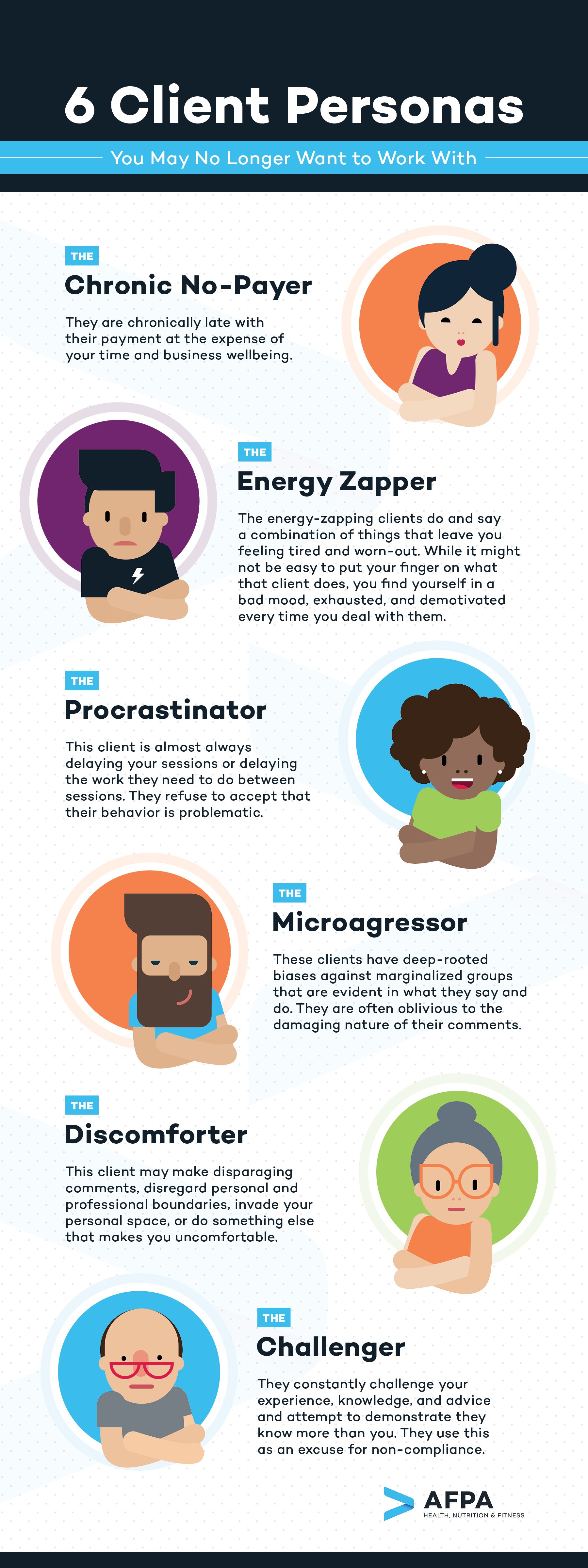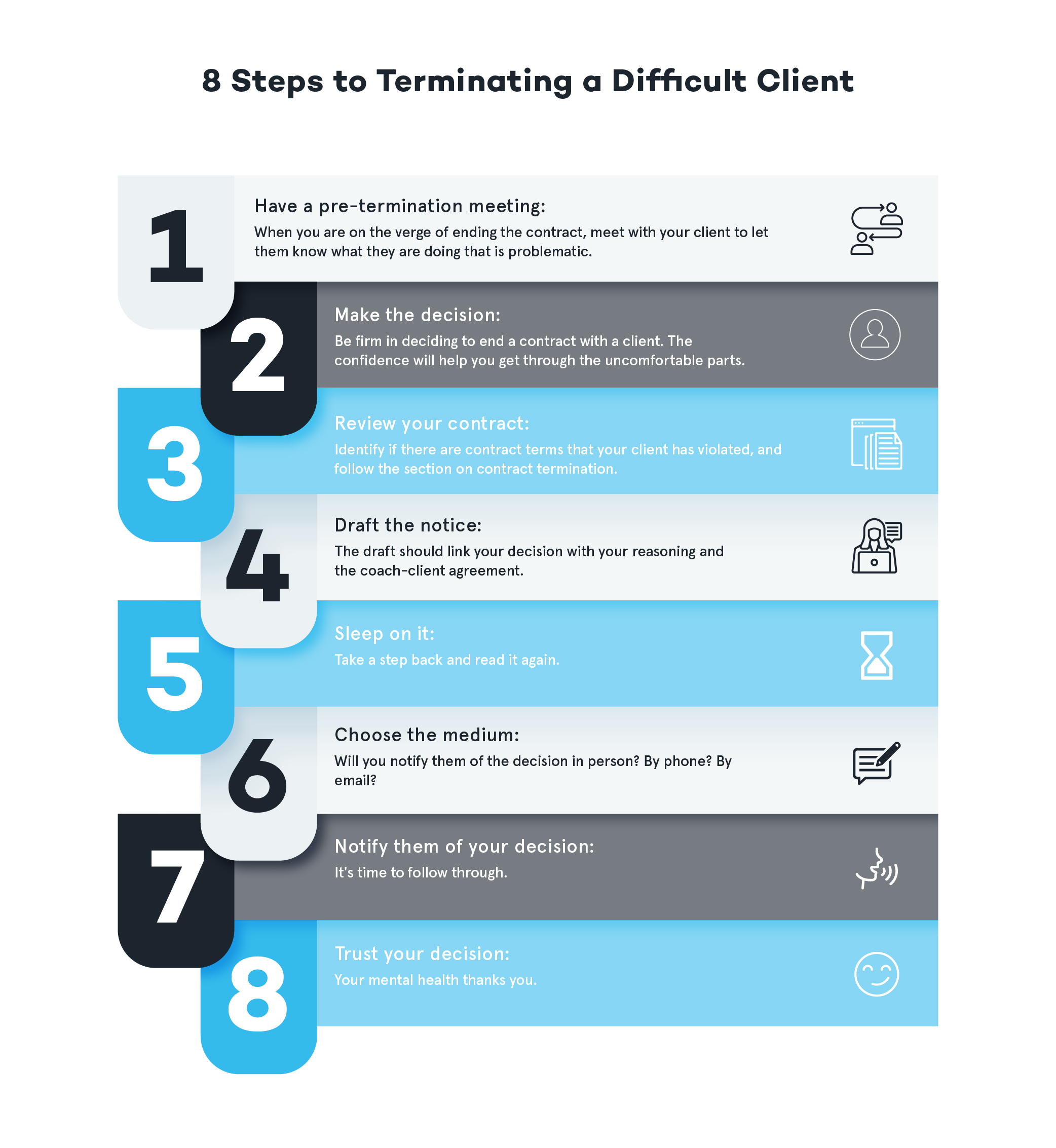Your next appointment is just minutes away, and you can’t help but cringe. You feel the tension in your neck as you picture yourself face-to-face with that client again.
It’s hard to believe you are even in this position. While you had given some thought to the possibility of a client quitting on you, you never thought about having to terminate a client.
You don’t always get this way—in fact, you are usually super pumped before your coaching appointments. But there’s just something about this client that makes you feel unlike yourself.
Of course, you know that as a fitness, health, or wellness professional, acting toward your client like you would toward your prankster sibling is just not appropriate.
So, what is the alternative? If you’ve found that keeping the client is more trouble than it’s worth, then it may be time to end the relationship.
Here, we’ll provide you with information that will help you navigate some of the thoughts, emotions, and feelings that arise with certain clients to help you determine if you want to end the contract. Once you’ve decided to do so, we will provide you with the tools and resources to help you to professionally terminate a client relationship.
6 Types of Clients You May Want to Terminate
It might feel strange to want to terminate a relationship or contract with a client. They are paying you money for a coaching or training service you’ve worked hard to build.
But something doesn’t feel right about that client…
Sometimes, the reasons you want to end the contract are clear; a client who is consistently behind on payment, for example, is easier to pinpoint as problematic for your business than a client who pays on time but is giving you some other kind of trouble.
Some clients may cause more problems to your mental wellbeing than the financial benefit they contribute to your business. Your mental health is essential not only to your personal wellbeing but also for you to be able to offer quality services to other clients.
For that reason, remember there are many valid reasons to want to terminate a client relationship. Here we’ve typified six different clients—some of which might resonate with you.
By finding a connection between your difficult client and one of these personas, you are taking a step toward identifying what the problem is so that you can create a plan of action to cut them out of your valuable coaching time.

The Chronic Non-Payer
These clients always seem to owe you money, and you suddenly feel like you’re working for a collections agency.
They pay late but promise they’ll get it to you as soon as they can. At the same time, these clients continue to schedule sessions with you and rob you of your valuable time.
The Chronic Non-Payer isn’t someone who gets a bit behind on their payment to you on rare occasions but always pulls through. It also isn’t someone who is truly going through a difficult situation, like losing a job, having to pay medical bills or house repairs, or helping out a family member.
The Chronic Non-Payer tries to get out of paying you what they owe while still taking advantage of your services as long as possible. They may also be a person always looking for a discount, one which you feel is unfair.
While empathy is very important in the coaching business, you also need to be sure you value your time and effort. Once your client’s lack of payment starts to become your burden, it’s probably time to call it quits.
Before you end the relationship, TRY THIS:
First, try and find out why they aren’t paying you. If there are budgetary issues, you can try to rework your packages to offer something that fits their budget. It is up to you whether you want to forgive them of what they owe you or not. If it isn’t clear why they are paying late, show them a calendar of their payment due dates and the dates they are actually paying (if at all). Give them a summary of their bill to date, and let them know that per your contract, you will be unable to continue to offer them your services until they pay the bill and commit to paying on time.
If that doesn’t work, it may be time to end the relationship.
The Procrastinator
The Procrastinator is always canceling their sessions, classes, and appointments with you, and they often do it at the very last minute. You end up having a gap in your schedule that you can’t fill, and unless you’ve enforced a cancellation fee, you’re also missing that income.
Sometimes, the Procrastinators put off the work they need to get done in between sessions. They make their appointments on time, but they have clearly done little to none of what they committed to doing during your last session—they didn’t train, they didn’t follow their meal plan, and they didn’t make an effort.
As a coach, having a chronically procrastinating client can be tricky because it is the perfect opportunity to understand why the client is procrastinating.
While having blips every now and then is absolutely normal as your clients try to make lifestyle changes, when not doing their part becomes a regular thing, it can be very frustrating to you as the coach.
Here’s the thing: The coach-coachee relationship is a two-way street. When the client doesn’t hold up their end of the bargain, it affects both of you:
→ Your client won’t be seeing differences in their health and fitness levels, so they’re wasting their money.
→ It could reflect poorly on your effectiveness as a coach that your client isn’t making changes. While you may still be getting paid, their lack of effort may make others feel like you aren’t doing your job.
If you’ve tried and tried to make changes to the coaching plan to make it work for your client but you still find them making excuses, it might be time to cut the cord.
Before you end the relationship, TRY THIS:
When you first notice a client is procrastinating, it is the perfect opportunity to put your coaching skills to work. Try to find out why the client is procrastinating. Ideally, it is an issue you can address by understanding where they are in the health behavior change continuum. If they are shut off to making changes or even accepting that their behavior is problematic for achieving their health goals, then it might be time to end the relationship.
The Discomforter
If you’ve had one of these clients, you know what we’re talking about. They make you uncomfortable, potentially making sexist jokes or disparaging comments about other genders, races, religions, or personal belief systems. They may also ask you out persistently, invade your personal space, disregard professional boundaries, or make borderline inappropriate comments.
In the fitness and health world, where a healthy body image is a pillar of good health and respect is important for any healthy work environment, these sorts of comments and actions have a negative impact on individuals and on the attempt to make safe spaces for improving health.
Before you end the relationship, TRY THIS:
As a coach, you might attempt to dig at the reason behind these thoughts and feelings with your client with the goal of finding roots for these problems in their own boundary or body image issues.
If a client does or says things that make you feel uncomfortable, you might find the opportunity to address the issue. Calmly and respectfully tell them how it makes you feel, and communicate to them how they can modify their behavior to avoid these feelings or thoughts.
Sometimes, however, you might find that it is neither your place nor responsibility to correct these thoughts and feelings or that it is not worth the emotional toll it will take on you to do so.
The Microaggressor
Microaggressions are one of those things that are hard to pinpoint or describe, but you can feel when they are happening.
What exactly are microaggressions?
Pierce, who coined the term microaggressions, used it “to refer to brief, sometimes subtle, everyday exchanges that either consciously or unconsciously disparage others based on their personal characteristics or perceived group membership.” The Microagressor’s comments or actions can make you feel invalidated, unseen, oversimplified, misunderstood, or just plain insulted.
So, when your client tells you that “you speak great English” even though English was your first language, or when they tell you that they’re happy to have a Black fitness coach because “you’re all great athletes,” or they make literally any comment that starts with the phrase “you people…”—those are all microaggressions.
Sometimes, the microaggressions might not be against you or the group you identify with, but you notice their racial, cultural, or gender biases. These can make you uncomfortable, and you don’t want to be complacent with that sort of behavior.
Before you end the relationship, TRY THIS:
If you feel the desire to let the client know how their behavior, words, and thoughts are impacting you and those around them, take a moment during or apart from one of your sessions to discuss the issue. Use specific examples, and explain to them how they made you feel, what it says about what and how they think, and how these thoughts and actions are damaging. If you feel unsafe, ask a trusted colleague who is aware of the situation to sit with you while you talk to them.
If your client gets defensive, calls you “oversensitive,” or another similar comment, it’s likely time to end the relationship with that client.
The Challenger
Every once in a while, you run into a client who seems to be constantly challenging your advice and recommendations.
As coaches, we welcome a productive discussion about the newest research or how exercise, food, and supplements work in the body, and we want clients to take an active role in their health by doing the research. However, when a client consistently chooses to go against your advice for no particular reason, it can be very frustrating for you as the coach.
Note that Challengers are different from well-informed clients. Well-informed clients are genuinely interested in owning their health and want to engage in productive conversations with you to understand what the best way is to move forward.
On the other hand, Challengers often challenge what you say because your advice isn’t convenient to them, it doesn’t imply a quick fix, or simply because it isn’t what they want to hear.
The two main ways that Challengers will go against your advice are either with their words or their actions (or both).
- Challenging words: They may start with, “but I read that…” or “but my mom always said…,” or they may even quote another nutritionist, trainer, or health coach. Usually, their point of reference is inconsistent and not of good quality.
- Challenging actions: They agree with you on an exercise or meal plan and consistently don’t follow through. Unlike the Procrastinator, the Challenger usually comes back with a semi-researched reason as to why they chose not to do what you recommended.
Katya Schade, an AFPA-certified Health and Wellness Coach who runs a combined chiropractic-nutrition office, has a motto: “A patient or client is either working their way into the practice or working their way out.”
Katya explains, “It doesn’t mean we don’t do our best, rather the opposite. We very solidly know what we do, and we offer the best to our clients/patients at all times. Most thrive (work their way in); some do not click with our mission (work their way out). I have learned to stick to my best recommendations when it comes to nutrition and be cautious when a patient constantly falls into noncompliance.”
A fundamental part of coaching is not only an alignment in approach but also in relationship. You should not have to compromise on your business and coaching values. Trust in your knowledge, experience, and instinct, and if a client isn’t willing to accept the facts, and it is affecting your progress, you might want to say bye.
Before you end the relationship, TRY THIS:
Sometimes a client pushing back all the time means the approach doesn’t resonate with them. So, before throwing in the towel, take the opportunity to take a critical look at your own method. They may not be Challengers, but clients who are genuinely informed about alternatives. Before firing them, ask them to provide feedback on what they think is best and why. If you fundamentally agree that their points are still good for their health, try an alternative approach.
If you notice they are challenging you because they are looking for an excuse to make changes and are unwilling to own it, it might be time to end the relationship before you burn out.
The Energy Zapper
The energy-zapping clients do and say a combination of things that leave you feeling tired and worn-out. While it might not be easy to put your finger on what that client does, you find yourself in a bad mood, exhausted, and demotivated every time you deal with them.
These clients might have one or a combination of the following traits or habits:
- They reach out at odd hours or too often.
- They are chronically negative.
- They criticize you, your plans, and/or the gym’s equipment constantly.
- They bring their judgmental attitudes to their sessions with you.
- They prefer to gossip rather than do the work.
- They complain or whine about everything they need to do for their health and fitness plan.
- They have issues that a mental health professional should be dealing with.
Note: If you’ve noticed that your client has serious mental health issues that are becoming evident with your interactions with them, it is important to recognize it and refer them to a specialist.
Before you end the relationship, TRY THIS:
Self-reflection is an important step for you as the coach when you have an Energy-Zapping client. Try and identify what it is about the client’s behavior that is draining you.
Some key actions that can keep your mind fresh could be setting boundaries around the session time and making those boundaries clear, setting expectations up front in the agreement and before each interaction, and reflecting with your client about changes and challenges before each interaction. You might even want to implement “stay positive” rules or gratitude mindsets with your client during sessions. These methods can help clients be more aware of their behavior, and they may motivate behavior change.
If after you’ve identified the problem and you’ve made boundaries and expectations clearer and your client chooses to constantly overstep those boundaries, then it is time to end the relationship.

The Essential Business Course for Health and Wellness Entrepreneurs
Gain the skills needed to build and run a thriving, lucrative health and wellness business.
8 Steps to Ending a Client Relationship the Right Way
Once you’ve decided that you are ready to let a client go, how do you actually go about doing it? Having a clear plan and a path to follow can significantly relieve stress.
Here, we’ve designed 8 steps to effectively “break up” with a client, and we’ve provided an email and phone script template for you to do so professionally.
Keep the following principles in mind when it comes to ending a relationship:
- Be honest. It can be uncomfortable to tell a client their racist or sexist comments make you not want to work with them anymore. But it is important to be truthful and let the client know the reason you have decided to no longer work with them.
- Be specific. If possible, be prepared to communicate what your client did that ultimately led you to make the decision. Note that it might be multiple small occurrences rather than one big one.
- Be clear. If you don’t want to discuss the possibility of giving the client another chance, make it clear that you are not open to negotiation.
- Be tactful. You can be honest and clear while still being tactful. Tactfulness is important to keep the relationship professional and to avoid misunderstandings.
Keep these principles in mind as you read through the steps for how to end the relationship without burning bridges.

Pre-termination meeting
In general, before you decide to end a contract, make sure you have communicated with your client that you are not in agreement with their behavior. During your regular one-on-one meeting times, create a space for “checking in” where both sides can share how they have been feeling with the progress. Here, you can discuss client behaviors that are not conducive to their productivity or a positive coach-client relationship.
Make the decision
One of the most difficult steps for some coaches when it comes to firing a client is making the final decision. In your notebook or on your computer, write out the following:
- On (DATE), I have decided to end my client contract with X. The reasons for doing this are as follows:
- Reason 1: Be honest, specific, and clear.
- Reason 2: Be honest, specific, and clear.
- etc…
Review your contract
Remember that your contract is the central document that outlines your business relationship with your client, and it is legally binding. Make note of the clauses that your client is violating, and make reference to the “termination of contract” clause. When relevant and possible, link your reasoning behind the decision to end the contract.
If you don’t have a written contract, look up emails or text messages, or recall when you had discussions about the expectations and responsibilities of the work you do.
Draft the notice (try our free email template)
The draft should link your decision with your reasoning and the contractual agreement. One way to structure your notice or script is as follows:
- Greeting and well-wishing.
- Affirm your mission.
- Inform your client of your decision to terminate the contract.
- Outline the reasoning behind the decision. Make references to meetings where you tried to troubleshoot the issue and parts of the contract that aren’t being honored as the business relationship currently stands.
- If a refund is in order, be clear about how and when it will be issued.
- Well-wishing for their health and wellbeing.
We’ve created an email template for you to follow for your contract termination notice. The template is meant to be a guide. Feel free to edit and modify the template as you wish.
Sleep on it
Making the decision to end a contract can be difficult, especially if you’ve had a visceral or emotional reaction to your client’s behavior. When you communicate with the client, remember that you will be free of that burden. By sleeping on it and reviewing your email or script before sending the notice, you will be able to take some time to read your notice calmly.
Try to be as matter-of-fact as possible. When it is relevant, you can mention how your client’s actions have had an effect on your emotional and mental wellbeing if that is one of the main reasons for the termination, but try to be as succinct as possible. Remember, you don’t need to justify your feeling of discomfort.
Choose the medium
You can choose to tell them in person, by phone or video call, or by email. We don’t recommend you end a contract via text message.
- In person: Set up a time to meet to discuss the contract. Make sure they know that the meeting is not for discussing their progress or their plan, and that they won’t be charged for it.
- By phone or video call: Avoid calling them without previously setting up a time to do so. You want to make sure you have their full attention.
- By email: If email exchange is your usual method of communication with clients, this might be the best method for you to inform your client of your decision. Note that, even when you choose to speak to them by phone or in person, you should always follow up with an email summarizing what was discussed so you have a physical record of the call. If your email allows it, set it up so that you know when your client has opened the email.
Notify them of your decision
With your script in hand, make that call or send that email. If you want to have the meeting in person, practice beforehand, but keep notes in front of you in case you need support.
Trust your decision
Take a big breath, and remind yourself that unless you take care of yourself, it is difficult to look out for others’ health.
Ending a relationship with a client can be difficult, but if you feel relief, you know you made the right decision.
Once you’ve made a decision, trust yourself, breathe, and move on.
Remember… Change Can Be Hard
A person knocks on your door because they are aware they need to make changes for their health and wellbeing. When people have made the same choices for long periods of time, any change or challenge to that way of life is going to be difficult.
That being said, it is normal for a client to show some resistance, make some mistakes, fall a bit behind now and then, lose motivation, and have a difficult attitude on a bad day.
It is important for you as a coach to recognize these attitudes as a normal response a person makes to difficult changes. As a first recourse, always use your coaching toolbox to get clients back on track, motivated, have self-confidence, and moving forward with your agreed-upon plan.
Cortney Shockley, AFPA-certified Personal Trainer and Health and Wellness Consultant, suggests that coaches exhaust their options first. Have a plan for clients (like the Procrastinator, the Challenger, and the Energy Zapper) who are “falling off the wagon” to help get them back to following your recommendations and making choices that promote their health.
Some other clients, like the No-Payer, the Discomforter, and the Microagressor, have issues that are usually out of the scope of your work as a health and wellness coach, and dealing with them regularly may be more damaging to your mental health than their payment is worth.
The Client Isn’t Always Right
As fitness, health, and nutrition coaches, remember that you aren’t selling a one-size-fits-all product, and you aren’t a short-order cook.
You are a health professional who is sought out specifically because of what you bring to the table.
You have your values and mission, your way of working, your knowledge, and your experience. All of those form the way you offer your services with the primary goal of helping others achieve health.
But when clients or potential clients don’t align with who you are and what you want to help clients achieve, you do not need to tailor your services to them, and you certainly do not need to sacrifice your mental, emotional, or financial wellbeing because of it.
While it is important to have a mind open to improvement, there are times when the client is in the wrong, and you have the right to decide who to take on and who not to.
Main Takeaways
It doesn’t happen often, but when you consider ending a relationship with a client, navigating the situation can be difficult. In this article, we illustrated different types of difficult clients, as described by how they may be affecting your coaching business. Then we shared how to “break up” with a difficult client in eight steps.
The most difficult part of the process of firing a client can be when you finally communicate with them. For that reason, we have created an email template that you can adapt to your needs.
Here’s to caring about your health and protecting what your business stands for!

The Essential Business Course for Health and Wellness Entrepreneurs
Gain the skills needed to build and run a thriving, lucrative health and wellness business.



